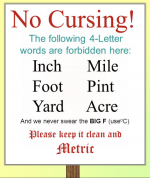mino
Member
Easy. If you expect to have a need for fractions, you make your sizes in multiples of them.Packard said:But can you as easily divide in 3rds, 4ths and 6ths?
10 divided by 3 is messy.
12 divided by three is 4.
...
The 32mm standard is about that - 32/96 - 16+16 - 24+24+24+24 - 8+8+8 etc.
Or you use base-60 sizes, but still in metric.
This is no different if using whole inches as your "base" so your fractions are then simple.
There are advantages of writing 1(") instead of 32(mm) the same as are advantages to writing 24 (mm) instead of 2/3 ("). Especially when those 2/3" are not marked anywhere and have to be approximated with power-of-2 fractions.
The decimal system is way more flexible here as you can choose to measure in a unit most suitable for he task - you would generally use unit small-enough to minimise fractions.
I make some drawings in CM, some in MM, some in M as it is easy to have them relate to each other, just moving the dot.
But as said. If 90% of what one does lends well to the 1" as a unit and sticks to power-of-2 fractions - which a lot of WW does - then inches can be more efficient for an individual workflow.
Once you need to integrate into smaller and/or bigger (like micro-electronics sizes and building-sizes) the decimal system base on a single unit goes on top.
The real "problem" is we all operate in a decimal(base 10) system otherwise as that is the standard that won the mathematics system "wars". Had we operated in a duodecimal (base 12) one, where 10" (duodecimal) would be 1' and where there would be a unit equivalent to 1/10" (duodecimal) having its own name, (equivalent to 2.116mm), and there would be 10' (3657,6mm) again having its own name. Then it may even work better using inches and feet. But we are not there and the system is "incomplete" making it "boxed-in" kinda.
/lands back on earth surface
Let me guess - it has a "sea" of markings, none of them clearly or easily identifiable as "main" marking. When you compare it to the metric ones (or pure imperial ones) there is just no comparison on ergonomy.ChuckS said:In what ways do the Fastcap tapes fall short?smorgasbord said:I don't understand why people like the FastCap tape measures. Mine sucks.Snip.


